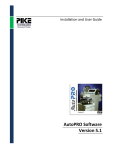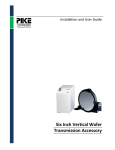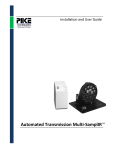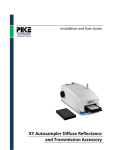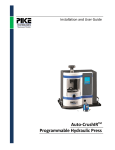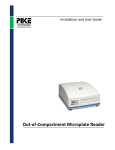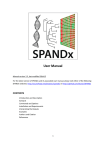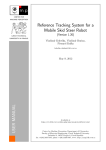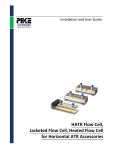Download AutoDiff Automated Diffuse Reflectance Accessory
Transcript
Installation and User Guide AutoDiff TM Automated Diffuse Reflectance Accessory The information in this publication is provided for reference only. All information contained in this publication is believed to be correct and complete. PIKE Technologies, Inc. shall not be liable for errors contained herein nor for incidental or consequential damages in connection with the furnishing, performance, or use of this material. All product specifications, as well as the information contained in this publication, are subject to change without notice. This publication may contain or reference information and products protected by copyrights or patents and does not convey any license under the patent rights of PIKE Technologies, Inc. nor the rights of others. PIKE Technologies, Inc. does not assume any liability arising out of any infringements of patents or other rights of third parties. This document contains confidential or proprietary information of PIKE Technologies, Inc. Neither this document nor the information herein is to be reproduced, distributed, used or disclosed, either in whole or in part, except as specifically authorized by PIKE Technologies, Inc. PIKE Technologies, Inc. makes no warranty of any kind with regard to this material including, but not limited to, the implied warranties of merchantability and fitness for a particular purpose. Copyright 1991-2014 by PIKE Technologies, Inc., Madison, WI 53719. Printed in the United States of America. All world rights reserved. No part of this publication may be stored in a retrieval system, transmitted, or reproduced in any way, including but not limited to, photocopy, photograph, magnetic or other record, without the prior written permission of PIKE Technologies, Inc. Address Comments to: PIKE Technologies, Inc. 6125 Cottonwood Drive Madison, WI 53719 Phone Fax E-mail Web Site Jan. 1, 2014 (608) 274-2721 (608) 274-0103 [email protected] www.piketech.com Contents Introduction Unpacking Your Accessory Packing List 1 2 2 Optical Description 4 Installation Loading the Sample Tray 5 6 Alignment Installing the AutoPRO Motor Controller 7 9 Connecting the Motor Controller to Your Computer Correct Cabling Procedure 9 10 Installation of the AutoPRO Software System Requirements 10 10 Loading from Windows Files Placed on Your Hard Disk Online Help 10 11 12 How to Use Help 12 AutoPRO Overview 13 AutoPRO Control 13 Status 15 Init.exe, First.exe… 15 Sample Preparation for the AutoDiff 16 Sample Cups Preparing the Sample 16 16 Loading the Sample 17 Theory 18 Introduction The PIKE Technologies AutoDiffTM is a high performance automated diffuse reflection accessory which is available for most FTIR Spectrometers. The design employs a high efficiency fixed ellipsoidal mirror to collect the maximum amount of diffusely reflected energy from the sample. Operating under program control from within the FTIR software, the data generated may be processed either sequentially after each scan or stored to disk for further analysis. The sample holder contains positions for sixty samples. Also, in the center of the sample holder is a position for a background sample. This background sample usually consists of pure KBr powder. The sample holder is marked into 6 areas, labeled from A to F. Each area has 10 sample positions marked from 1 through 10. The samples are moved automatically into position in the infrared beam by means of the Motion Controller and AutoPROTM software. An R-Theta motion is used by the accessory for positioning each sample. Figure 1. AutoDiff accessory PN 350-043001-02 P a g e |1 Unpacking Your Accessory In order for you to quickly verify receipt of your accessory, we have included a packing list. Please inspect the package carefully. Packing List AutoDiff Manual AutoPRO Manual and Software AutoDiff Accessory PN 350-090000 PN 350-000070 PN 043-28XX Quantity 1 Quantity 1 Quantity 1 60-Position Sample Tray Sample Cups, large Motor Controller PN 042-2025 PN 043-3090 Quantity 1 Quantity 1 Quantity 60 USB Cable 15-Pin Male/Male Accessory Cable Power Cable Quantity 1 Quantity 1 Quantity 1 PN 350-043001-02 P a g e |2 Packing List, continued Sampling Preparation Kit Purge Rings Purge Kit PN 042-3040 Quantity 8 Quantity 1 Quantity 1 Hex Wrench Set Extra Fuses (2 amps each) Quantity 1 Quantity 2 PN 350-043001-02 P a g e |3 Optical Description The optical system of the AutoDiff is symmetrical with identical mirrors being used for the optical path from the spectrometer interferometer to the sample and the sample to the spectrometer detector. Two flat mirrors and an ellipsoidal mirror are used in each path. The two lower mirrors are adjustable and are used for aligning the optical system at installation. The upper flat mirrors and ellipsoid mirror are fixed in position. The ellipsoid is a large solid-angle monolithic mirror which condenses the beam onto the sample with a power of 3 times. If the beam in your spectrometer sample compartment with no accessory in place is 9 mm in diameter, the size of the focused spot at the sample in the AutoDiff is 3 mm. Note that the size of the beam in the spectrometer is dependent on manufacturer. Refer to your spectrometer user guide for the correct size. Figure 2. Optical path of the AutoDiff accessory PN 350-043001-02 P a g e |4 Installation Inspect the drawing below and locate the indicated items on your accessory. Sample Cup Sample Tray Focus Adjust Knob Purge Tube Purge Fitting Front Cover Screws Figure 3. Front view of the AutoDiff To install the accessory in your sample compartment perform the following: 1. With the sample compartment of the spectrometer empty, scan a background with your FTIR software and save to disk. This single beam spectrum can be used to verify the performance of the system. 2. If your accessory is equipped with the instrument’s manufacturer standard baseplate, remove the original sample compartment baseplate from the spectrometer. Place the accessory in the sample compartment and secure it with screws used for baseplate attachment. PN 350-043001-02 P a g e |5 3. If the accessory uses a sub-plate that attaches to the instrument’s original sample compartment baseplate, remove the lower front cover of the accessory first. Place the AutoDiff in the sample compartment of the spectrometer and position it on the baseplate pins. Find a captive thumbscrew located on the bottom plate of the accessory and tighten it securely. Reinstall the front cover. 4. Using a 3/32” wrench, loosen the screws on the two purge seal tubes on the sides of the accessory. Push the tubes toward the side walls of the spectrometer. This will seal the accessory and ease future placement of the accessory in the sample compartment. Loading the Sample Tray 1. Place the sample tray in the accessory. 2. Holding the sample tray horizontally, slightly tilt the tray, so the left part of the tray is approximately one inch higher than the right part of the tray. 3. Place the sample tray over both the spring loaded idler and driving gear. Make sure that the sample tray is completely over the driving gear, and the gear is located in the “V” shaped portion on the underside of the tray. 4. Push backwards to compress the idler spring. You may need to hold the sample stage to prevent it from moving backwards. Two holes are provided in the front of the sample stage to help in doing this. 5. Rotate the sample tray so that it is horizontal and fits over the fixed idler. 6. Gently release the sample tray so that it is located on all three supports. The sample tray is now in place in the accessory. Fixed Idler Driving Gear Spring Loaded Idler Figure 4. Sample Stage of the AutoDiff accessory PN 350-043001-02 P a g e |6 Alignment 1. Place the alignment mirror included in the Sample Preparation Kit into the center position. Note that this alignment mirror is provided with a protective film. Follow the instructions in the Sample Preparation Kit to remove this film. 2. Remove the four thumbscrews holding the lower front cover in place and remove the cover. Behind this cover are two adjustable mirrors which are used for alignment. Focus Knob Mirror Adjust Screws Figure 5. Interior view of AutoDiff mirror configuration 3. Set up the FTIR software to alignment or monitor mode and note the size of the interferogram. Turn the focus adjust knob to raise and lower the sample tray to achieve maximum throughput. 4. Adjust the output adjustable mirror. This is the mirror that is the closest to the instrument detector. Turn both screws on this mirror mount to maximize throughput. PN 350-043001-02 P a g e |7 5. Adjust the focus knob to maximize throughput. 6. Adjust the input adjustable mirror. This is the mirror that is the closest to the instrument interferometer. Turn both screws on this mirror mount to maximize throughput. 7. Adjust the focus knob to maximize throughput. 8. Repeat the last four steps until there is no further increase in signal. Typically, you should achieve a signal throughput which is at least thirty percent of the signal that was present before the accessory was placed into the sample compartment. 9. Replace the lower front cover and fix in place with the four thumb screws. Figure 6. Typical energy throughput spectrum PN 350-043001-02 P a g e |8 Installing the AutoPRO Motor Controller The motion control electronics interface the MappIR to your computer. Commands are sent to this electronics unit using a USB cable. A 15-pin accessory cable is used to connect this unit to the accessory. Connecting the Motor Controller to Your Computer The power supply for the motor controller is self-adjusting and can be used in most locations. Please read the labels on the rear of the motor controller before attempting to connect the system. The power for the motor controller should always be turned off when attaching the cables. Figure 7. Motor Controller rear panel PN 350-043001-02 P a g e |9 Correct Cabling Procedure Computer to Motor Controller USB Cable Computer 15-Pin Male/Male Accessory Cable PIKE Motor Controller to Accessory Motor Controller PIKE Accessory Figure 8. Correct cabling procedure for the AutoDiff • The accessory port of the motor controller should be connected to the accessory through the 6 foot, male-to-male 15-pin cable provided. • Connect the USB cable from the controller to the PC. Installation of the AutoPRO Software System Requirements AutoPRO is a Microsoft Windows compliant program. The program was designed to run within XP or Windows 7 32 bit and 64 bit. Loading from Windows 1. Insert the program disk into the CD-ROM drive of your computer. 2. If the installation doesn’t start automatically from within the Program Manager, select Run from the File Menu. The Run dialog box will appear to enter a filename. 3. You may either enter x:setup.exe or “browse” to the CD Disk directory and select setup.exe. PN 350-043001-02 P a g e | 10 A setup dialog box will appear for a few moments while the installation program checks for available memory and configuration. The AutoPRO dialog box will appear: • • • Choose to use the default path and select: Choose to enter an alternative path and then select: Choose to exit Setup by selecting: Enter, or Enter, or EXIT The software will be copied. The source and destination files, and the percentage of the completed task are displayed. A dialog box will appear when the program has been loaded. Click on the OK button to complete installation. Files Placed on Your Hard Disk During installation the following files are placed on your hard drive in the AutoPRO subdirectory: Ap5.exe main AutoPRO app Apd5.exe programmer for AutoDiffusIR Apv5.exe programmer for VeeMax ,ATRmax and polarizers (stand-alone) Apvp5.exe programmer for VeeMax and ATRMax with polarizers (combinations) Apw5.exe programmer for wafer stages - MappIR, Map300, Six inch, Autosamplers Apxy5.exe programmer for XY plate reader Comment.exe self-contained executable that writes into the spectral header First.exe self-contained executable that moves the stage to the first point in profile Init.exe self-contained executable that initializes the stage and moves it home Load.exe self-contained executable that loads the stage Newfile.exe self-contained executable that opens the file open dialog box Next.exe self-contained executable that moves the stage to the next point in the profile Point.exe self-contained executable that moves the stage to point n of the profile Unload.exe self-contained executable that unloads the stage Ap5.hlp Help files 350-000700 AutoPRO software.pdf AutoPRO5 operation manual PN 350-043001-02 P a g e | 11 Sample profiles installed in the AutoPRO5\Profile subdirectory: • • • • • example.vep example.apd example.xya example.map example.waf • • • • • example.pol example.atr example.vee 18 point samp.waf 36 point sample.map Sample macros installed in the AutoPRO5\Macro subdirectory: • • • • • Preexp.ab preexp.bas presamp.ab presamp.bas postsamp.ab • • • • postsamp.bas postexp.ab postexp.bas ap5.bas On-Screen Help AutoPRO provides on-screen help for commands and functions. More information on the general attributes of the Help screens may be found in the AutoPRO Manual. How to Use Help Choose Help from the menu, or press F1 on the keyboard. • • • Index - Displays an index of Help topics including menus, commands, and shortcuts. Using Help - Provides information on how to use Windows Help. About - Provides specific information regarding the version of AutoPRO and current system information. You can use the Help buttons to display related Help topics. Options are: • • • • • Contents - Displays a list of Help topics. Search - Lists the keywords for AutoPRO. Enter a keyword or phrase in the Search For text box or select a keyword from the list box. Back - Displays the last topic you displayed. History - Displays a list of recent topics displayed. Glossary - Displays a list of terms and parameters used in AutoPRO and their definitions. PN 350-043001-02 P a g e | 12 AutoPRO Overview AutoPRO is a Windows based automation software program for use with PIKE automated accessories and the AutoPRO motion controller. With this software package a range of automated accessories may be programmed and operated in conjunction with most Windows based FTIR software packages such as Windows XP,and Windows 7 32 bit and 64 bit. Several programs comprise the complete software package, but the following two programs are central to the function of the software and will be introduced briefly here. AutoPRO Control This program contains the tools required to operate your automated accessory. The AutoPRO control panel contains the following major functions: • Setup Bench - Basic parameters for data collection (number of scans, resolution, etc.) may be defined and stored to a file. • Setup Accessory - This function allows selection of the actual accessory used with the spectrometer, computer/accessory communication test, and basic accessory setup. PN 350-043001-02 P a g e | 13 • Setup Experiment - Macros and executable files can be integrated into the autosampler routine. This function also allows special handling of multiple filenames and provides different security options. • Program Motions - A series of samples may be defined and stored to a file. This file may be subsequently used to move your accessory while collecting data from your spectrometer. • Load and Unload - The AutoDiff may be moved to an unload position to simplify the insertion of new samples. PN 350-043001-02 P a g e | 14 Status The status of the accessory at any time is displayed. This includes the position of the accessory, the current status of the motors and a thumbnail view of the file being used for programming the motion. These and all other functions are described fully in the AutoPRO manual. Init.exe, First.exe… These are programs which may be inserted into an FTIR macro. With these programs the basic functions required to run the accessory may be accessed from within the macro. While the software is running a small AutoPRO status box is displayed in the lower right hand corner. More details of how to use this and other .exe files available in the AutoPRO software are given in the AutoPRO User’s Manual. PN 350-043001-02 P a g e | 15 Sample Preparation The AutoDiff is provided with a sample preparation system to aid in the accurate and repeatable preparation of samples. With this system, the sample cups may be filled precisely with minimum sample spillage and inconvenience. Sample Cups 60 large-sized sample cups are provided. The large sample cup has a 10 mm diameter by 2.3 mm deep rebate to hold the sample. Small cups are also available measuring 4.7 mm diameter by 1.6 mm deep. Figure 9. Sample Cup Preparing the Sample The sample to be analyzed is often diluted in a transmitting matrix when making mid-infrared measurements. Place the sample in the mortar and grind finely using the pestle provided. Add KBr powder to the sample. With the pestle, mix the sample with the KBr powder so that the sample particles are small and evenly dispersed. The sample should be diluted to 1% to 5%. The optimum amount of dilution will depend on the sample to be analyzed but the percent transmission of the strongest band in the resulting spectrum should ideally be in the range from 10% to 50%. If possible start with a 5% dilution and if the resulting bands are too intense then redilute the sample. To enhance particle size consistency, the ShakIR sample grinder is recommended. CAUTION: KBr readily absorbs moisture. To reduce the effect of moisture in the sample spectrum the following guidelines should be used. Always keep the cap on the KBr bottle when not in use. If possible store the KBr in a dry place. Fill the reference cup (neat KBr) and the sample cup (sample diluted in KBr) at the same time. Any water that has been absorbed in the reference and sample will tend to ratio out in the final spectrum. PN 350-043001-02 P a g e | 16 Loading the Sample Two sets of parts are provided. Identify the parts with reference to the drawings below. Figure 10. Sample Preparation Base The base has a 0.25 inch hole in the center and a raised lip around this hole. Figure 11. Sample Holder The sample holder has a 0.5 inch hole in its center. With the sample prepared in the mortar, place the sample cup in the sample preparation base. Figure 12. Sample Cup mounted in the Base PN 350-043001-02 P a g e | 17 Place the holder over the sample cup. The sample cup will appear to be slightly proud of the surface of the holder. The sample cups have a small bevel on the top surface. This enables a high quality sample surface to be prepared. Sample Bevel Figure 13. Sample Cup Pour the sample from the mortar into the sample holder. The cup may now be filled using the spatula and razor blade provided. The cup may be placed on a surface as shown in Figure 14 below to prevent it from tipping. With practice, a perfect repeatable sample surface may be prepared. Figure 14. Sample Cup mounted in the Base and Holder Theory Diffuse reflectance spectroscopy is a widely used technique in FTIR analysis. The primary application is in the analysis of powders, although it has been used for investigating rough surfaces and even fibers. In diffuse reflectance spectroscopy, the sample is mixed with an infrared transmitting powder. When the beam strikes the sample, three things happen: 1. Some of the beam is specularly reflected. The amount of energy reflected is governed by the Fresnel equations which state that the reflectivity of a sample is dependent on the refractive index of the sample. At an absorption band, the refractive index changes widely, an effect known as anomalous dispersion, and this gives rise to a reflection spectrum. PN 350-043001-02 P a g e | 18 2. Some of the beam is absorbed in the sample and is lost. 3. The remainder of the beam is transmitted into the sample. Only that part of the beam that is scattered within the sample and returned to the surface may be collected. This energy is diffusely reflected energy and is collected by the accessory. Specular Reflection Diffuse Reflection Incident Radiation Figure 15. Sample Cup mounted in the Base The optics of a diffuse reflectance accessory are designed to do two things: 1. Focus all of the infrared energy from the spectrometer onto the sample. 2. Collect as much diffusely reflected energy from the sample as possible. This energy is scattered into a complete hemisphere, and it is important that the optics of the accessory collect this energy efficiently and direct it to the instrument detector. A key point in the use of a diffuse reflectance accessory is sample preparation. The sample is usually ground and mixed with a material such as potassium bromide, which acts as an infrared transmitting matrix. The sample is diluted in this matrix to give a 1% to 5% mixture. In this way the infrared beam penetrates into the sample cup and maximizes the detected signal. The depth of the sample that is required is governed by the amount of scattering in the sample. The minimum depth of sample required is about 1.5 mm, and this is known as the “infinite depth” of the sample. In order to produce a diffuse reflectance spectrum, a background spectrum must first be collected. The sample used for this background spectrum is the pure matrix material (i.e. KBr). The background sample is placed in one position on the sample cup slide. The prepared sample to be analyzed is placed in the other sample position. The resulting spectrum is produced by ratioing the sample spectrum to the background spectrum. PN 350-043001-02 P a g e | 19 Samples may also be analyzed without dilution. For samples that are not powders, the sample may be abraded with a piece of silicon carbide. The Abrasive Sampling Kit is available from PIKE Technologies. For this technique a background spectrum is taken of the clean silicon carbide paper prior to abrading the sample. The spectra that are obtained by the diffuse reflection technique appear different from standard transmission spectra. The peak intensities at high wavenumbers are weak and the peak line shapes are rounded. The spectra can be transformed into Kubelka-Munk units, compensating for these differences. The reflectance of a sample is related to concentration by the Kubelka-Munk equation: Where R is the absolute reflectance of the sampled layer k is the molar absorption coefficient and s is the scattering coefficient The scattering coefficient depends on both the particle size and sample packing, which explains why sample preparation is important for accurate results. In order to perform a Kubelka-Munk Transform, select Kubelka-Munk from the menu of your FTIR software. There are no parameters to set for this routine. The Kubelka-Munk equation creates a linear relationship for spectral intensity relative to sample concentration (it assumes infinite sample dilution in a non-absorbing matrix, a constant scattering coefficient and an “infinitely thick” sample layer). These conditions can be achieved for highly diluted, small particle samples (the scattering coefficient is a function of sample size and packing) and a sample layer of at least 1.5 mm. With proper sample preparation diffuse, reflectance spectroscopy can provide ppm sensitivity and high quality results. PN 350-043001-02 P a g e | 20 100 95 90 85 80 %T 75 70 65 60 55 50 45 40 4000 3500 3000 2500 2000 Wavenumbers (cm-1) 1500 1000 500 1000 500 Figure 16. Raw Diffuse Reflectance Spectrum, Caffeine 0.50 0.45 0.40 0.35 KM 0.30 0.25 0.20 0.15 0.10 0.05 -0.00 4000 3500 3000 2500 2000 Wavenumbers (cm-1) 1500 Figure 17. Kubelka-Munk Transformed Spectrum, Caffeine PN 350-043001-02 P a g e | 21 6125 Cottonwood Drive · Madison, WI 53719-5120 · (608) 274-2721 (TEL) · (608) 274-0103 (FAX) [email protected] · www.piketech.com


























